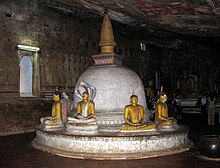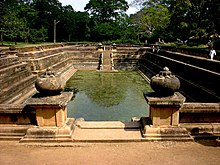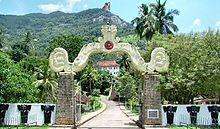 |
Buddha statues in Dambulla Rock Temple
|
Cave temples had been used in Sri Lanka since ancient times, fine examples if these include the magnificent cave temple complex in Dambulla built by king Valagamba. Cave temples has preserved some of the best examples of Sinhalese art and Sinhalese architecture. In the years gone by of monarchy rule in ancient Sri Lanka the rock cave shelters cloistered in the recess of the forests served the recluse Buddhist monks in performing their meditation chores and other religious observances. Such cave hermitages were patronised by the ruling kings of the time, chieftains and the people as well. As the years passed, such cave shelters turned into len viharas (cave temples) and len avasas (abodes of Buddhist monks). Such len (cave shelters), were donated by kings, queens and other royalty and nobility. Foremost among such noble chieftains were the paramukas (chieftain of royal rank holding multiple designations).
Vessagiri:
Vessagiri, or Issarasamanarama, is an ancient Buddhist forest monastery that is part of the ruins of Anuradhapura, one of the ancient capitals of Sri Lanka. It is located about half a mile south of Isurumuniya, among boulders. Begun in the reign of King Devanampiya Tissa (mid-3rd century BC), the site was expanded during the reign of King Kasyapa (473 - 491 AD) to become home to about five hundred monks.

The Vessagiri monks lived in rock shelters that were constructed by quarrying from local materials. Today's visitor sees only the bare stones - and not all of those, since much of the rock was later carted away and reused elsewhere. But when occupied, the dwellings were finished using wood and other perishable materials.
Dambulla Cave Temple:
 Dambulla cave temple (Sinhalese: Dam̆būlū Len Vihāraya, Tamil Tampuḷḷai Poṟkōvil) also known as the Golden Temple of Dambulla is a World Heritage Site (1991) in Sri Lanka, situated in the central part of the country.This site is situated 148 kilometres (92 mi) east of Colombo and 72 kilometres (45 mi) north of Kandy.
Dambulla cave temple (Sinhalese: Dam̆būlū Len Vihāraya, Tamil Tampuḷḷai Poṟkōvil) also known as the Golden Temple of Dambulla is a World Heritage Site (1991) in Sri Lanka, situated in the central part of the country.This site is situated 148 kilometres (92 mi) east of Colombo and 72 kilometres (45 mi) north of Kandy.
It is the largest and best-preserved cave temple complex in Sri Lanka. The rock towers 160 m over the surrounding plains.There are more than 80 documented caves in the surrounding area. Major attractions are spread over five caves, which contain statues and paintings. These paintings and statues are related to Gautama Buddha and his life. There are a total of 153 Buddha statues, three statues of Sri Lankan kings and four statues of gods and goddesses. The latter include Vishnu and the Ganesha. The murals cover an area of 2,100 square metres (23,000 sq ft). Depictions on the walls of the caves include the temptation by the demon Mara, and Buddha's first sermon.
Prehistoric Sri Lankans would have lived in these cave complexes before the arrival of Buddhism in Sri Lanka as there are burial sites with human skeletons about 2700 years old in this area, at Ibbankatuwa near the Dambulla cave complexes.
Pilikuththuwa Raja Maha viharaya:
Pilikuththuwa Raja Maha Vihara (Sinhalaː පිළිකුත්තුව රජ මහා විහාරය ) is an ancient Cave temple situated in Mahara of Gampaha, Sri Lanka. It is located on Gampaha - Wathurugama road approximately 3.8 km (2.4 mi) away from Miriswatta junction and 1.6 km (0.99 mi) from the ancient Buddhist temple, Maligatenna Raja Maha Vihara. Currently this temple has been declared as one of archaeological site in Sri Lanka.
Pilikuththuwa Raja Maha Vihara is considered as one of the Buddhist temple with highest number of drip ledged rock caves in Sri Lanka. It is said that this temple has 99 rock caves with drip ledges, spread about 200 acres of total area. As today 77 of caves have been identified and their numbers are marked on each cave.
Beside the rock caves, numbers of water tanks with underground water channels, large number of Ola leaf manuscripts, paintings of Kandyan era and old wooden bridge with Dutch architectural features can be found in the vihara premises.
History
As the archaeological evidences, it is believed that this area was inhabited since pre historic time periods. Also three rock inscriptions with Brahmi characters, found in the caves in vihara premises prove that Pilikuththuwa temple is existed as a religious place since pre-Christian era. According to the legends connected with this temple describe King Valagamba (89-77 BC) used to stay in this historical place from time to time during the invasion from South India.
Uruwala, Maligatenna, Warana, Miriswatta and Koskandawala cave temples, situated in the vicinity of the Pilikuththuwa cave complex are also said to be from one major cave site in the early Anuradhapura period.
Aluvihara Rock Cave Temple:
The Aluvihare Rock Temple (also called Matale Alu Viharaya) is a sacred Buddhist temple located in Aluvihare, Matale District of Sri Lanka.Surrounded by hills, the Aluvihara cave temple is situated 30 km north of Kandy on the Matale-Dambulla road. The history of Aluvihare Rock Temple is traced back to the 3rd Century B.C to the reign of King Devanampiyatissa. It is believed that the King built the dagoba, planted the Bo sapling and founded the temple after the introduction of Buddhism to the country during his reign.
Aluvihare Rock Temple was the historic location where the Pāli Canon was first written down completely in text on ola (palm) leaves. Many monastery caves, some of which exhibit frescoes are situated near this temple.
Dimbulagala Raja Maha Viharaya:

Dimbulagala Raja Maha Vihara is situated 16 kilometres south east of the ancient city of Polonnaruwa, Sri Lanka. The Dimbulagala range houses a number of caves cut into the rock with Brahmi inscriptions over their drip ledges. This forest hermitage of medieval times and holy abode since time immemorial, home to some of the most valued fragments of early frescoes was called the
Gunners Quoin by the British. This Buddhist monastery which was abandoned after the times of the Kingdom of Polonnaruwa was restored to the present status in the 1950s due to the efforts of Kithalagama Sri Seelalankara Thera, who was the chief incumbent of the Vihara until his death in 1995.
 One of the best specimen of bathing tanks or pools in ancient Sri Lanka is the pair of pools known as Kuttam Pokuna (Twin Ponds/Pools). The said pair of pools were built by the Sinhalese in the ancient kingdom of Anuradhapura. These are considered one of the significant achievements in the field of hydrological engineering and outstanding architectural and artistic creations of the ancient Sinhalese.
One of the best specimen of bathing tanks or pools in ancient Sri Lanka is the pair of pools known as Kuttam Pokuna (Twin Ponds/Pools). The said pair of pools were built by the Sinhalese in the ancient kingdom of Anuradhapura. These are considered one of the significant achievements in the field of hydrological engineering and outstanding architectural and artistic creations of the ancient Sinhalese.







